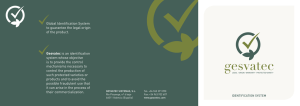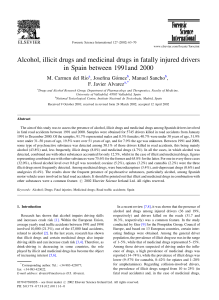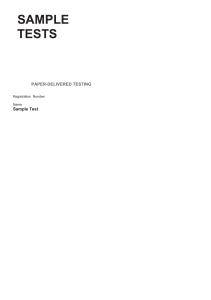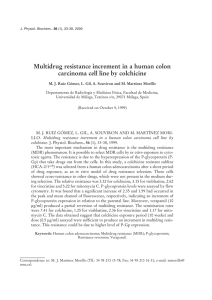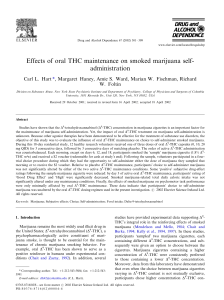illegal drug market in Mexico City
Anuncio
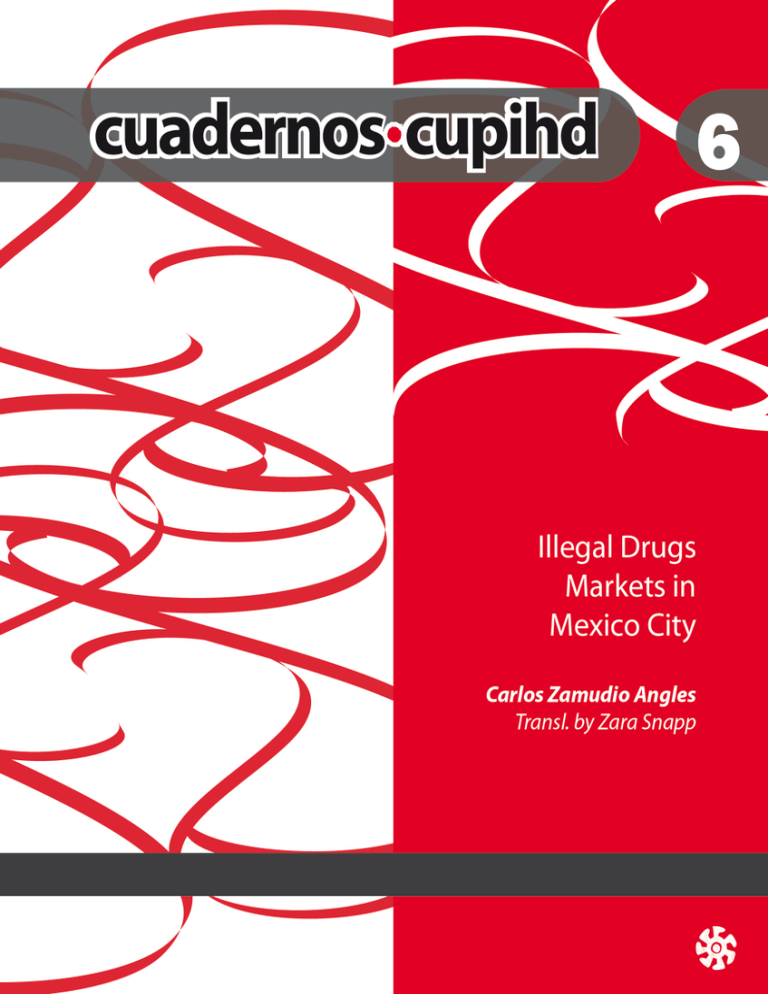
Drugs DF , A. C. www.cupihd.org Una producción original del Colectivo por una Política Integral hacia las Drogas, AC. Morelos 70-202, colonia del Carmen, Coyoacán, C. P. 04100 tels. 56586518 / 56581406 / www.cupihd.org / [email protected] Con el apoyo de Open Society Foundations DIGITAL VERSION Introduction In this sixth edition titled Drugs DF, CuPIHD presents a statistical, qualitative, informative and quality analysis of the dynamics and characteristics of illegal drug markets and drug users, particularly within Mexico City. Drugs DF describes the size and characteristics of the drug market in Mexico City, as well as the perceptions and relationships of drug users with their legal, economic, institutional and social environments. Using this research, we highlight the most important market dynamics within Mexico City in order to effectively deal with the issue of drugs and drug policy, not only in Mexico City, but also in all of Mexican society. We are positive that Drugs DF will be a helpful, practical tool for researchers, policy-makers and civil society that are committed to designing and implementing public policies related to illegal drugs. We hope that it will also be informative for those who have interest in going deeper in their understanding of a complex phenomenon, filled with misinformation and prejudice. We hope this publication will contribute to a better understanding of illegal drug markets, its dynamics and actors, in such a way that we can begin constructing alternatives to our current drug policies. Drugs DF Illegal Drugs Markets in Mexico City Carlos Zamudio Angles Translation by Zara Snapp The primary goal of this investigation is to understand the dimensions and characteristics of the illegal drug market in Mexico City based on five elements: i. Market Size, ii. User Profiles, iii. Economic Value, iv. Sales Mechanisms, v. The Law in Practice, and vi. Law Enforcement and Users i. Market Size 5 To explore the links between institutions and drug users, this work is based on data from four different surveys1, along with additional data from the Public Security Secretariat of Mexico City (SSPDF) and the Mexico City Attorney General’s Office (PGRDF). Since it is difficult to gain a precise data set from an illegal market, this research does all that is possible to make a clear approximation concerning the size and characteristics of the drug using population. Data from these various sources show that the incidence of lifetime illegal drug use has minimally grown with 8.5% over the past 13 years and only 1.2% in the past three years. In comparison, yearly prevalence increased by 21% in the past 13 years and decreased by 6% over the past three years and has essentially maintained stable over the past four years. National Addiction Survey (ENA) from 1998 and 2008, Mexico City Survey on Addiction (EADF) from 2006, MiddleIncome Mexico City Students Survey (EENM) from 1991-2009 and the Survey on Illegal Drug Users in Mexico City (EUDI) from 2011. 1 Table 1. Prevalence of illicit drug use in Mexico City2 1998 2006 2008 20113 % % N % N % N Lifetime Prevalence (use) 7.28 12.73 615,257 7.8 506,064 7.9 522,393 Annual Prevalence Actual Prevalence (used in the last month) 1.4 2.39 115,326 1.8 118,600 1.7 113,832 0.95 1.4 67,707 1.3 82,895 1.3 85,819 Source: 1: ENA 1998, 2008, 2011 and EADF 2006 We consider that the true demand of the illegal drug market are users who have used an illegal substance in the past month---rather than those who have used in the past year or in their lifetime, since they are not currently engaging with the illegal market and might never have accessed it, particularly if their use was restricted to gifts of illegal drugs. Based on data from the 2001 National Addiction Survey, there are 85,819 “clients” of the illegal drug market in Mexico City. For the sake of analyzing this data, we assume that the number of illegal drug users in the last month is equivalent to the demand of the illegal drug market. 6 The 2002 National Addiction Survey did not publish specific data for Mexico City. 2 The 2011 National Addiction Survey only published data related to Lifetime and Annual prevalence rates. See Conadic, 2012 and Villatoro & cols., 2012. 3 Based on the annual prevalence rate and actual use of illegal drugs, it is clear that marijuana and amphetamine users represent the two largest groups within the illicit drug market. Marijuana users make up 85% of the market with 72,702 users, while amphetamine users represent 7% of the market for a total 5,721 users. Since it is clear that the majority of illicit drug users consume marijuana, it becomes ever more urgent to regulate this substance as a means to provide secure access and remove these users from the black market, thus opening up the space to offer health services based on their needs. Table 2. Prevalence of illegal drug users in Mexico City: 2008-2011. Annual Prevalence 2008 Actual Prevalence 2011 2008 2011 Illegal Drugs 1.8 118,600 1.7 113,832 1.3 82,895 100 1.3 85,819 100 Marijuana 1.7 110,903 1.5 101,659 1.2 76,801 92.6 1.1 72,702 84.7 Cocaine 0.3 17,082 0.1 4,000 0.1 4,289 5.2 0 1,888 2.2 Crack 0.1 3,406 0.1 3,364 0.1 3,406 4.1 0.1 3,364 3.9 0.1 4,640 0.1 5,721 5.6 5,721 6.7 10,453 4,640 0.1 0.2 0.1 0.1 4,459 5.2 0.3 16,853 0.1 8,003 0.1 3,849 4.6 0 2,009 2.3 Amphetamines Methamphetamines Hallucinogens Source: Databases from the National Addiction Survey in 2008 and 2011 ii. User Profiles According to data from the 2011 National Addiction Survey, there were 63,318 males and 19,336 females who used illicit substances in the last month. This signifies a ratio of 3 male: 1 female users, while in 2008 the ratio was 2 males for every female, demonstrating an increase in illegal drug use among males, although it is unclear what is behind this trend. Among young people, women are a growing population of illicit drug users, with a steady increase of 2% in 2003, 3% in 2006 and up to 6.7% in 2009, which translates into a 223% increase in the last six years. Within the drug using population, not all users exclusively use one drug; rather the majority is more likely to consume one or more illegal substances, since mixing is quite common. Unfortunately, the official government surveys do not have indicators which track the number of illicit drug users that mix or combine drugs. In order to fill that gap, CuPIHD conducted the first Illegal Drug Users Survey and found that almost two out of three users are multi drug users, meaning that they consume two or more illicit substances on a regular basis. As 7 table 3 shows, more than 70% of users consume more than one substance, which means that they access more than one illegal drug market and probably have several points of sale that allow them access to their substances of choice. In contrast, one in four consumers use one substance (28.2%) and are considered mono-users. Table 3. Illegal drug users based on number of substances used, 2011. N= 429 Type of drug use Proportion of users Mono-users of illicit drugs (only use one substance) 28.2 Multidrug users who use few illicit drugs (between 2-3 substances) 44.3 Multidrug users who use various illicit drugs (4 or more substances) 27.4 Source: Database from the Illegal Drug Users Survey. In conclusion, the majority of the illicit drug market is made up of young men, however the proportion of female users is increasing, particularly among the student population. In addition, most illicit drug users are multi drug users (71.7%), and most multidrug users consume 2-3 illicit substances (44.3%). 8 iii. Economic Value of Illicit Drug Markets Based on a $1 USD= 13 Mex pesos conversion rate. 4 The economic value of the various illicit drug markets was based on the data obtained from the first Illegal Drug User Survey, which found that 33 of every 100 drug users spent less than $3.80 USD4 per week on illicit drugs, 19 of every 100 spend between $3.81-$7.60 USD per week on illicit drugs, 21 of every 100 spend between $15.46-$38.46 USD per week on illicit drugs and 14 of every 100 spend more than $38.47 USD per week on illicit drugs. Only 9.4% of mono-drug users spend over $150 USD per month on drugs, while 13.6% of multidrug users (that use two or three drugs) spend that amount on a monthly basis and 17% of multidrug users who use more than three drugs over $150 USD. Based on this data, we can identify a difference between mono and multidrug users. The average weekly amount spent on illicit drugs is $21.55 USD, which equals a yearly amount of $1,120.80. To disaggregate the data a bit more, mono-users have a weekly average spending of $18.32 USD, while multidrug users of two to three drugs spend $21.73 USD and multidrug users who use more three substances spend $23.71 USD weekly. This equals an average yearly spending of $952.80 USD, $1130 USD, and $1233.20 USD respectively. In order to approximate the total value of the illegal drug market in Mexico City, we will use the average weekly spending of $21.55 USD. Considering the average spending per consumer and the dimensions of the market ($21.55 weekly spending x 85,819 users5), we find that the maximum value of the illegal drug market is $1,849,399.45 USD on a weekly bases and/or $96,168,771.49 USD on a yearly basis. It is important to note that the economic value of the market has grown in recent years, with the increase attributed to the introduction of new varieties of marijuana and emerging designer drugs, which have a greater value, as well as the increase in stimulant users, which has grown from 2008 to 20116. If you look at the market another way, we see that the total value is more than 10 times the budget provided to the Institute for Attention and Prevention of Addiction in Mexico City7 in 2012. 9 iv. Sales Mechanisms The sales mechanisms can be differentiated within three scenarios: Fixed locations, semi-fixed and mobile dealing. • Fixed locations are places where dealers distribute and sell drugs during a range of hours, thus allowing easy access to consumers. In order to cover this wide-range of hours, there is a rotation among dealers to sell and stand watch for the authorities. Because these locations are fixed, they are more vulnerable to being apprehended and shut down by the authorities. • Semi-fixed locations are places, usually public where users can meet to consume drugs, and where dealers are often present to sell substances. These places tend to have a limited time period for buying, when dealers are present, and they can often blend in among users, thus Based on the 2011 National Addiction Survey. 5 This refers to crack, cocaine and other amphetamine-type stimulants (ATS). 6 Instituto para la Atención y Prevención de las Adicciones (IAPA). 7 making it harder to identify the dealer. The most common places for this to occur is in parks, concerts or universities. • Mobile dealing occurs in places where the dealer and consumer exchange money for drugs and the dealer only stays in the area while the deal is occurring. This means of transaction allows dealers to quickly move through the city and diminishes their risk of being caught by the authorities. These deals usually occur in high traffic areas, which allows for less detection of what is occurring. This mechanism is mainly used in middle-high class areas where there is less risk. The diverse means of buying drugs allows dealers to provide users with the possibility of deciding where and how they would like to buy their substances. Based on data from the first Illegal Drug User Survey, we found that 33% of illicit drug users bought their substances from fixed locations, 17% bought from semi-fixed locations and another 29% bought from various locations. Outside of the market, 11% obtain substances from their friends and only 0.2% cultivates for personal use. Table 4. Primary means of obtaining illicit drugs 10 Friends Fixed Locations Semi-fixed Locations Mobile dealing Cultivate Total illicit drug users (N= 413) 11.1 32.7 10.2 16.7 0.2 29.1 Mono-users of illicit drugs (n= 117) 10.3 34.2 11.1 18.8 0 25.6 Multidrug users of few illicit drugs (n= 170) 10.6 35.9 10 15.9 0 27.6 Multidrug users of various illicit drugs (n= 126) 12.7 27 9.5 15.9 0.8 34.1 Type of user Various Source: Database from the Illegal Drug Users Survey Most drug users can identify an average of seven places where they can purchase drugs, whereas mono-users know of five, multidrug users of two to three drugs know of 6.9 and multidrug users who use more than three drugs know of 8.5 points of sale. This tendency by multidrug users to know of more points of sale suggests that a higher use of drugs means that users have greater contact with drug dealers and thus they know of more than a few places to buy drugs as they seek a variety of substances at the most accessible price. Since multidrug users on average spend more than mono-users, it is in their interest to find the cheapest price, just as it is in the interest of dealers that their clients use and buy a higher number of substances. The importance of having many sales points and people who are willing to sell means that users maintain continued access to substances, even if the police of other authorities arrest or incarcerate dealers. Because of the diversity and high number of people willing to sell, the law on small-scale trafficking has had little to no effect on reducing either the demand or the supply of drugs in Mexico City. On the other hand, if the goal of the government is to decrease the number of relationships or contact between users and dealers and in that way prevent multidrug use and mixing substances, the data suggests that it would be necessary to offer users regulated access to illicit drugs. v. The Law in Practice In August 2009, a new law took effect that reformed the Federal Health Law, the Federal Criminal Code and the Federal Criminal Procedures Code. Known as the Small-Scale Drug Dealing Law (Ley Table 5. Decriminalization Amounts Substance Maximum Amount Allowed for Personal Use Opium 2 grams Heroin 50 milligrams Marijuana 5 grams Cocaine 500 milligrams LSD .015 milligrams MDMA 40 milligrams Methamphetamine 40 milligrams 11 contra el Narcomenudeo) because of its primary objective to combat small-scale sale of drugs, the law established maximum quantities of different kinds of narcotics allowed for personal consumption. This law was primarily implemented to differentiate between small-scale drug traffickers and dealers and people who were carrying substances for personal consumption. Drug users continue to be vulnerable to extortion by the authorities with two out of three marijuana users reporting bribing police officers in order to not be detained and/or arrested. According to data from the Public Security Secretariat of Mexico City, between January 2009 and May 2012, there were 26,233 referrals and 28,463 people detained by the police for crimes against health (or drug crimes). Table 6. Referrals and number of people detained at police stations for crimes against health (drug crimes) 2009-2012 12 2009 2010 2011 2012 (En-My) Total Referrals 7,970 10,013 6,494 1,756 26,233 Total number of people detained at police stations 8,642 10.780 7,106 1,935 28,463 720 828 592 387 694 Referrals that only implicate 1 person (% of total referrals) 7,397 (92.8) 9,377 (93.6) 6,031 (92.9) 1,618 (92.1) 24,423 (93.1) Referrals that implicate 3 or more people (% of total referrals) 93 (1.2) 90 (0.9) 83 (1.3) 25 (1.4) 291 (1.1) Monthly average of people detained at police stations Source: CuPIHD’s own investigation from database from the SSPDF, Sub-secretary of Police Information and Intelligence However, while in 2009 and 2010, the SSPDF had a monthly average of 720 and 828 detained persons respectively, the average dropped to 592 in 2011 and 387 in 2012, when the small-scale trafficking law went into effect and local police forces were given new responsibilities. This decrease in detentions can be explained by the fact that crimes against health or drug crimes were no longer included in the category that are considered worthy of incentives by the Mexico City police department. This is a unique category of crimes that are “worthy” and imply some sort of monetary incentive for police, such as robbery, carrying arms or another high-level crime. This aligns with the decrease in detentions and referrals in 2011-2012. More than 90% of the referrals only implicate one person, which means that they must have been caught consuming in public, since buying and selling would implicate two people: the buyer and the seller. In addition, less than 2% of the cases implicated three or more people, which indicate that this is having a minimal impact in combating the links between high-level drug traffickers and low-level street dealers. This makes it much easier for dealers to be replaced and for users to be found in possession of drugs for personal use, rather than a true combat against organized crime. Since these cases can be categorized under organized crime, they have be investigated and sanctioned by the federal authorities. Since 2009, the number of people arrested for possession has continuously grown, even while Mexico maintains a de jure decriminalization law, with 24% of arrests for possession in 2009, 41% in 2010, 57% in 2011 and 57% in the first half of 2012. The crimes and data here correspond to people who were detained by the SSPDF, as well as other agents from security or justice institutions. 8 The percentages regarding consumption are included also in the percentages regarding possession, which is why the totals do not add up to 100%. 9 Table 7. Registered drug crimes in Mexico City, 2009-20128 2009 2010 2011 2012 En-My Totals 7,819 10,454 12,164 3,801 Selling 46 105 71 29 Supplying 1 3 1 0 1,893 (24.2) 4,320 (41.3) 6,970 (57.3) 2,197 (57.8) 32 (1.7) 1,360 (31.5) 2,901 (41.6) 1,052 (47.9) Possession (% of the total) Consumption9 (% for possession) Source: Attorney General’s Office, Institute of Statistical Information System 13 Arrests for consumption have increased with 31.5% in 2010, 41.6% in 2011 and 47.9% in the first half of 2012. The growing indicator of “consumption” would suggest that the authorities are able to distinguish between users and small-scale traffickers, but that they continue to be targeted for their use. This signifies a contradiction between the law, which allows for personal consumption and buying/selling, which continues to be a crime. According to data from the Attorney General’s Office, the only drugs that were interdicted between August – December 2012 were marijuana and cocaine, unless you count the 0.7 grams of methamphetamine and the 354 clonazepam pills. The lack of diversity of drugs could suggest that amphetamine-type stimulants are not being combated at the same level as the markets of marijuana and cocaine, which might explain the trends of why the ATS market has grown significantly since 2008, thus becoming the second largest market after marijuana. 14 The goal of the new law was ostensibly to provide users with greater rights and also to reduce congestion in the justice system of people detained for personal possession. Data has shown that the objective has not been reached due to the lack of quality implementation on behalf of the authorities. VI. Law Enforcement and Users Law enforcement differs across the different types of drug users. The situation for marijuana users (which make up 85% of all illicit drug users) is distinct from others because of the smell of the substance, thus making it easier to detect, both when it is being used and when it is carried in large quantities. The Illegal Drug Users Survey shows that two out of every three illicit drug users have been detained and extorted by the police or other authorities, particularly among multidrug users. Table 8. Relationships between users and authorities % that have been detained % that have been extorted % that believe that the police discriminate Illicit drug users (n=426) 67.8 66.9 93.7 Mono-users of illicit drugs (n=124) 59.7 60.5 85.5 Multidrug users of a few drugs (n=174) 67.2 66.7 96 Multidrug users of various drugs (n= 128) 76.6 73.6 98.4 Source: Database from the Illegal Drug Users Survey This high quantity of detentions might be explained by the fact that many users consume in public places or because they are detained and frisked only on the suspicion of having an illegal substance---and then because they are carrying drugs, they are arrested and taken to the police station with a charge of small-scale trafficking. On the other hand, many drug users often do assume the role of a drug dealer, with 22% of mono-users reportedly having sold drugs and 47.7% of multidrug users self-identifying as having sold drugs at some point. The fact that over a third of drug users have sold drugs shows the ease at which they can enter the commercial market. The data suggests that there is a greater propensity to enter that market if the user consumes more than one substance, which seems logical when we remember that this population has the greatest amount of contacts within the illegal drug market. In other words, the higher number of substances consumed is correlated to the connection to criminal networks and that eases the means by which a user participates in these networks. The local authorities have been challenged to enforce these laws and combat small-scale trafficking, which also takes into account the rights of users, and are not based on detentions and arrests. This has proved tricky for them since users have the perception (and reality) that the authorities discriminate and extort them, and at the same time, this pushes them closer to illicit activities, particularly the illegal drug market. 15 Conclusions The illegal drug market in Mexico City corresponds to around 85,000 users or clients, and of these, 85% are marijuana users, 7% are amphetamine users and 4% are crack or cocaine users. It is important to highlight the increasing proportion of female users, particularly among youth, where the market has found a new niche, thus it is clear that any attention to drug policy must also have a gender perspective. Excluding young women, the size of the market has maintained relatively low and stable. However, the market continues to develop and segment according to the emergence of new substances within the illegal drug market. 16 The weekly average spending on drugs amongst users is $21.53 USD and considering the market size of 85,000 users, this equals a market value of approximately $96 million dollars. The diversity of mechanisms by which users are able to obtain drugs explains the limitations of policies that seek to combat demand through the detention and arrest of small level dealers or shutting down points of sale. This means that the market has consumers who continue to access illicit drugs, even when some of their dealers have been arrested. Based on this framework, it will be impossible to follow through on the responsibilities of the authorities outlined in the Small-Scale Trafficking Law. In addition, many users are often mistaken for small-scale traffickers and charged with dealing under that law. While this has not served to contain the market, it has strengthened the ties of users with criminal networks and pushed them away from non-punitive services provided by the state. In conclusion, the data demonstrates a clear need for public policy alternatives which prevent the use of legal and illegal drugs among minors and particularly among young women; that recognizes and respects the human rights of adult users; as well as one that provides harm and risk reduction services that move users away from criminal networks, the black market and consumption in public places and which works to decrease cases of policy abuse and the feeling of social and political exclusion felt by people who use drugs.
